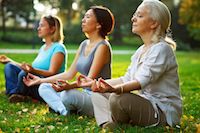What is yoga?

Yoga is a mind and body practice. It has a long history, and comes originally from India. It combines physical movement (postures), breath work, and meditation.
Who can practice yoga?
Almost anyone can practice yoga. You can be any age. You do not have to be very flexible. Yoga can be modified to meet your needs. But it is important to talk to your health care practitioner before you start. People with high blood pressure, glaucoma, sciatica and pregnant women will need to modify or avoid certain movements. You may want to start by taking a class with a teacher who can help you set up a home practice.
What are the benefits of yoga?

Yoga has many benefits. It helps you build your strength and flexibility. It also helps with your balance. Research has shown particular benefits for people with:
- anxiety
- chronic pain
- depression
- lower back pain
- osteoarthritis
It has also shown benefits for stress reduction.
Are there any side effects or risks?
Yoga is a low-impact exercise. It is generally safe for healthy people. The risk of serious injury is low. Rare side effects are certain types of stroke and pain from nerve damage. It is important to have a well trained instructor.
What are yoga classes like?
It depends on the type of yoga class you take. Some teachers take a more physically focused approach. Some combine more spiritual and physical elements.
Here are some common types:
- Gentle yoga: Classes are usually calming, relaxing, and move slowly. They use props like cushions or blocks to help students relax. This is also called restorative yoga.
- Flow yoga: Classes move more quickly. Each posture is usually held only for a short time before moving to the next posture.
- Alignment-oriented yoga: Classes give particular attention to the physical body’s alignment. The postures are usually held longer. Classes might use props to help students get their bodies into alignment.
- Hot yoga: Classes involve practicing in heated rooms.
- Specialty yoga: Classes are designed for different groups. This includes seniors, children, pregnant women, and those with special health conditions. Teachers who work with these groups should have special training.
Many yoga studios have a style or tradition. Here are a few common styles:
- Ashtanga
- Bikram
- Iyengar
- Kundalini
You can learn more about these styles on a yoga studio’s website.
How do I begin?
Think about the type of yoga you are interested in. You may need a teacher with special training. You can start by looking at the Yoga Alliance website (www.yogaalliance.org) or the International Association for Yoga Therapists (www.iayt.org) website. Many yoga studios offer introductory classes. You can ask your local gym or hospital about their yoga classes. Your health care practitioner also may be able to recommend someone.
Print Version
References/Resources
Additional Resources
National Center for Complementary and Integrative Health
References
Buffart L Physical and psychosocial benefits of yoga in cancer patients and survivors, a systematic review and meta-analysis of randomized controlled trials BMC Cancer. 2012; 12: 559.
Kiecolt-Glaser JK, Christian L, Preston H, et al. Stress, inflammation, and yoga practice. Psychosomatic Medicine. 2010;72(2):113–121.
Lipton L. Using yoga to treat disease: an evidence-based review. JAAPA. 2008;21(2):34–36, 38, 41.
Ross A, Thomas S. The health benefits of yoga and exercise: a review of comparison studies. Journal of Alternative and Complementary Medicine. 2010;16(1):3–12.
Patient Education Materials
- Acupuncture
- ADHD
- Allergic Rhinitis
- Anxiety
- Aromatherapy
- Asthma
- Autism
- Back Pain
- Biofeedback Therapy/Training
- Breathing Techniques
- Cancer Symptoms
- Chiropractic
- Constipation
- Depression
- Diabetes
- Dyslipidemia
- Eczema
- Elimination Diet
- Fibromyalgia
- GERD
- Headache
- Healthy Diet
- Healthy Weight / Obesity
- Heart Disease
- High Blood Pressure
- Inflammatory Bowel Disease
- Insomnia
- Irritable Bowel Syndrome (IBS)
- Massage Therapy
- Meditation
- Menopause
- Menstrual Disorders
- Osteoarthritis
- Physical Activity
- Probiotics
- Progressive Muscle Relaxation
- Rheumatoid Arthritis
- Supplements
- Tai Chi